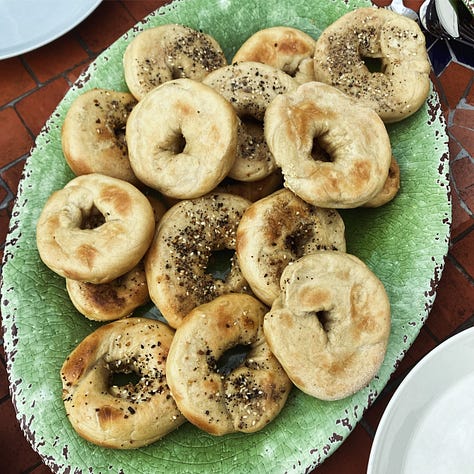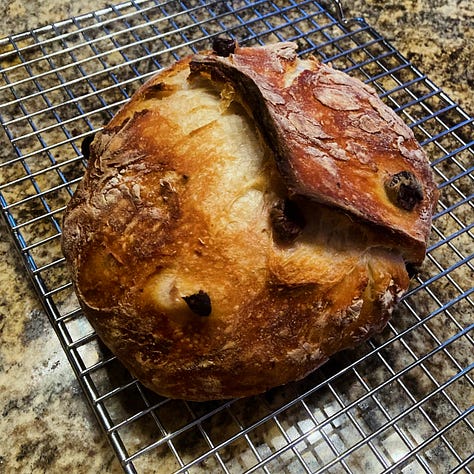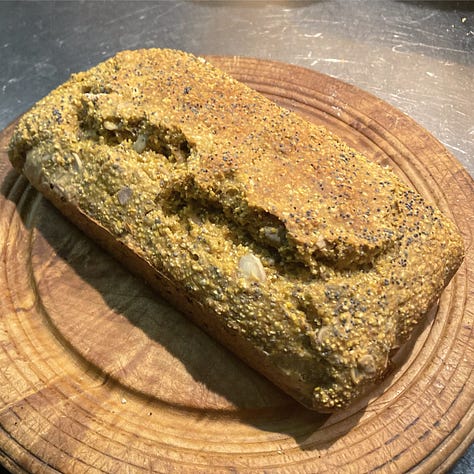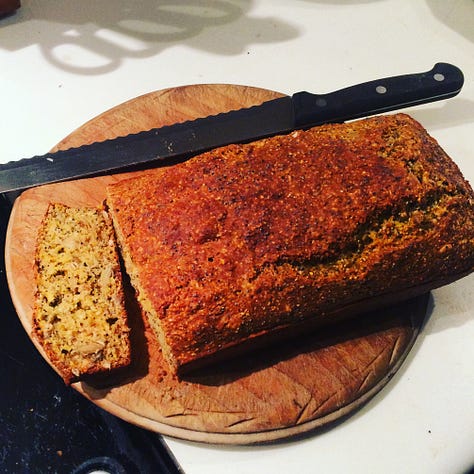Pane
I recently read an article about living longer, an idea that’s becoming increasingly appealing to me, in which Valter Longo, (which is a highly appropriate name, don’t you think?) explains that few modern Italians eat what we have come to know as the super-healthy Mediterranean diet of fish, vegetables, and olive oil. Instead, they are getting as fat and unhealthy as the rest of us by consuming what Longo calls “the poisonous five Ps — pizza, pasta, protein, potatoes and pane (or bread).”
My Mediterranean diet credentials are for the most part first rate. I eat so many fruits and vegetables that the recent 30 plant challenge, where people are challenged to eat 30 plants weekly (fruits, vegetables, and even coffee and spices all count), would probably be over by the first or second day of my typical week. Most of my protein comes in the form of beans, of which Longo approves, because I’ve been trying to cut back on fish since one of my daughters made me watch Seaspiracy. (If you haven’t already, I challenge you to watch this documentary and not feel a little uneasy at the fish counter.) And of course, beans have historically been in plentiful supply in my habitually over stocked cupboards.
But back to Longo’s poisonous Ps. These days, pizza is a rare treat, but potatoes and bread… these are quite simply two of my favourite things. There should have been a verse about them in that song from The Sound of Music. For me the best potato is fried or roasted. A feast without roast potatoes has to be spectacular in other areas to really count as a feast. And if I throw caution and diet to the wind and head out to dinner, I feel a little cheated not to consume some manner of highly calorific and deeply unhealthy fried or roasted spud.
When I am being good about my health, I satisfy my potato cravings with a baked potato, or jacket potato as I called them back in England. My favourite part is the skin which Italians and some other people shun but which contains numerous health benefits as well as being delicious. Obviously, the potato skin is at its most sublime glistening with unsalted butter, European not American, but if I am being good, I will eat it with mustard, French or English.
But what has all of this, apart from the bit about the beans, got to do with marginal living? Well, potatoes are cheap and I do have quite a number of jars of mustard in my stores, so there’s that. But it is when we move onto the second of my poisonous Ps that I will really get on topic…eventually.
Pane (or bread) has been a staple food since it was invented. I can remember chanting “Give us this day our daily bread” during my daily recital of “The Lord’s Prayer” at my school’s morning assembly. Throughout history, bread has been what those who can’t afford meat fill themselves up on. So you would think buying it would be well within the means of someone like me, trying to live on a budget. It turns out, however, that were I to buy a daily loaf, even of the type of bread I would never actually buy, here in Massachusetts it would cost me $117.60 a month. If I were to buy the bread I would actually buy it would cost closer to $180.
Obviously, I don’t eat a loaf of bread a day, but you get the point. Bread is actually pretty expensive. Far too expensive to be the staple it’s cracked up to be. And too expensive to be bought with abandon when I am trying to spend modestly. I am conducting my experiment to become a better person and for a bit of fun, but more and more Americans are struggling to feed their families, so the price of bread actually matters beyond this silly essay.
Luckily for me, I have a cupboard full of ingredients. So, I have been making a lot of bread since I started trying to spend less and reduce the excess in my house. Making bread is actually something I started to do a while ago. Early in the pandemic, like about half the world, it seems, I tried my hand at making sourdough starter. Like just under half the people in the world, my starter was really a non-starter. It grew in its pot but turned a nasty shade of gray. The bread I made with it didn’t rise, though it did taste a little sour as we cautiously bit into it, worrying about cracking our teeth at a time when all the dentists in the world were closed. After a couple of tries, and to the relief of my family, I gave up on sourdough.
Also at the start of the pandemic, I panic-bought a number of yeast packets, so next I tried making bread with these, with middling results. I think I am too impatient to wait for the yeast to work or to give it a situation that allows it to do its thing. And as for kneading. Forget it. My youngest daughter’s boyfriend makes the most spectacular no-knead bread, but even his apparently fool-proof recipe rarely works for me.



He also makes fabulous bagels and pretzels. I am in awe but unlikely to ever try making these things myself. They seem far too difficult. I have, however, hit on a sure fire bread recipe that requires no kneading, no yeast, and no patience, and that works every time. Soda bread.
Early in the pandemic, after the sourdough and regular bread fails, and after the time we thought the pandemic would be over in three weeks but before the time when we realized the supply chain would be unbroken and we weren’t going to have to dig victory gardens and start tending goats, one of my best friends brought over a loaf of soda bread she had made. Inspired, I found a soda bread recipe in a Delia Smith cookery book, and I have been basing regular soda bread creations on it ever since.
Soda bread is great. If you don’t have the wholemeal flour, Delia calls for, pastry flour works just as well. In fact, any flour seems to do the job just fine. Even that strange Fair Trade, flour you impulse bought at Whole Foods years ago will probably work perfectly. As long as I keep the proportions vaguely similar, I have discovered that just about anything can be added to Delia’s very traditional recipe. Got some grainy stuff sitting in a jar with no label? Throw it in. Nuts, seeds, meal, flakes, and bran? Perfect. Bits of dried fruit and coconut left over from baking sprees? In it all goes. Soda bread can be sweet or spicy, bland or startling. Olives, old chunks of cheese, chives, beetroot, pretty much anything you can imagine eating with bread, or in bread, can find a home in soda bread.
Delia’s recipe calls for buttermilk, but I soon discovered that this is to provide acid to react with the baking soda (yes, you do actually need this. No substitutes allowed if you want any rising action). But who keeps buttermilk in the fridge? And who has ever bought buttermilk for a recipe and managed to use what is left before it goes bad? Luckily, the internet told me I could achieve the same soda reaction by adding a squeeze of lemon juice to regular milk and letting it curdle. I have also made the bread by doing the same with almond and coconut milks. You might also be able to do it with water, but I haven’t tried yet. After you beat an egg into the acidic liquid, whatever that might be, you mix it with the dry ingredients, whatever they might be, and either put the sloppy mixture into a loaf pan or dollop it onto a baking tray, depending on how tidy you want the resulting loaf to look.



Soda bread really is incredibly versatile, and if, like me, you already have the bulk of the ingredients, incredibly cheap. At the same time as helping cut down on spending and speeding up decluttering, making your own bread, soda or otherwise, deals a small blow to the industrial food production that is driving up prices and lowering quality. It turns out that much of the bread people here in American are increasing their debt to buy is actually rather bad for their health. American bread is far worse than the pane Dr. Longo worries about modern Italians eating because our government allows American manufacturers to chase higher profits by filling their bread with chemicals and additives that are illegal in Europe. So, live a little longer and make your own bread, and with the money you save, splurge on some decent butter to slather on when it’s fresh out of the oven. Yum.





